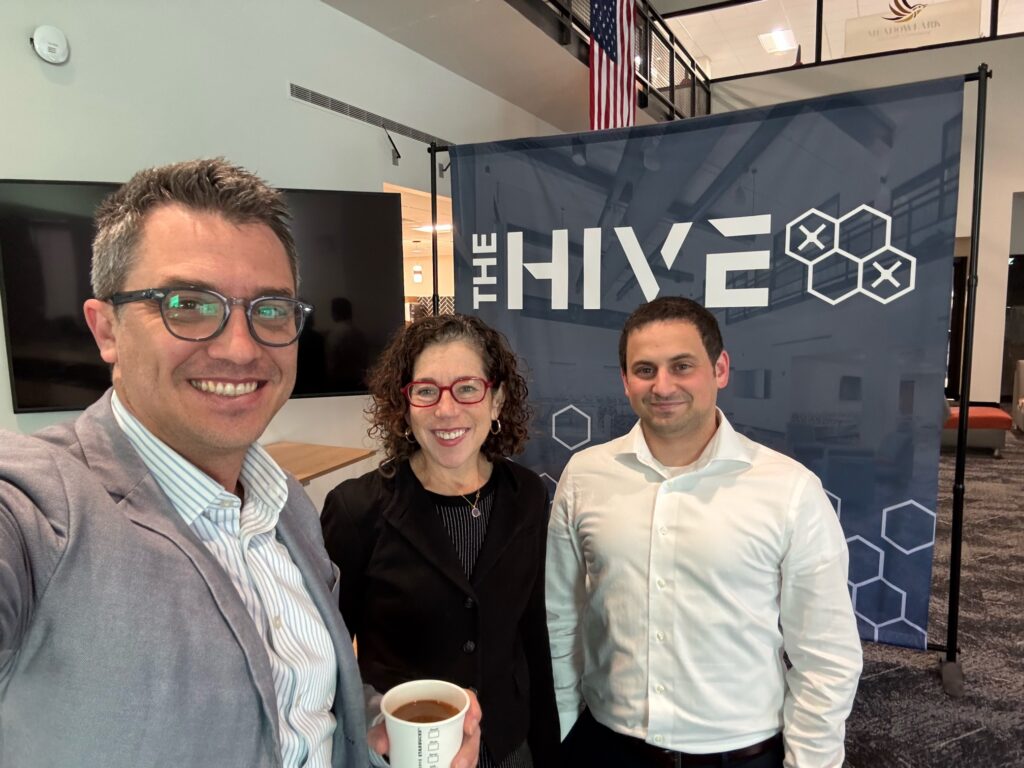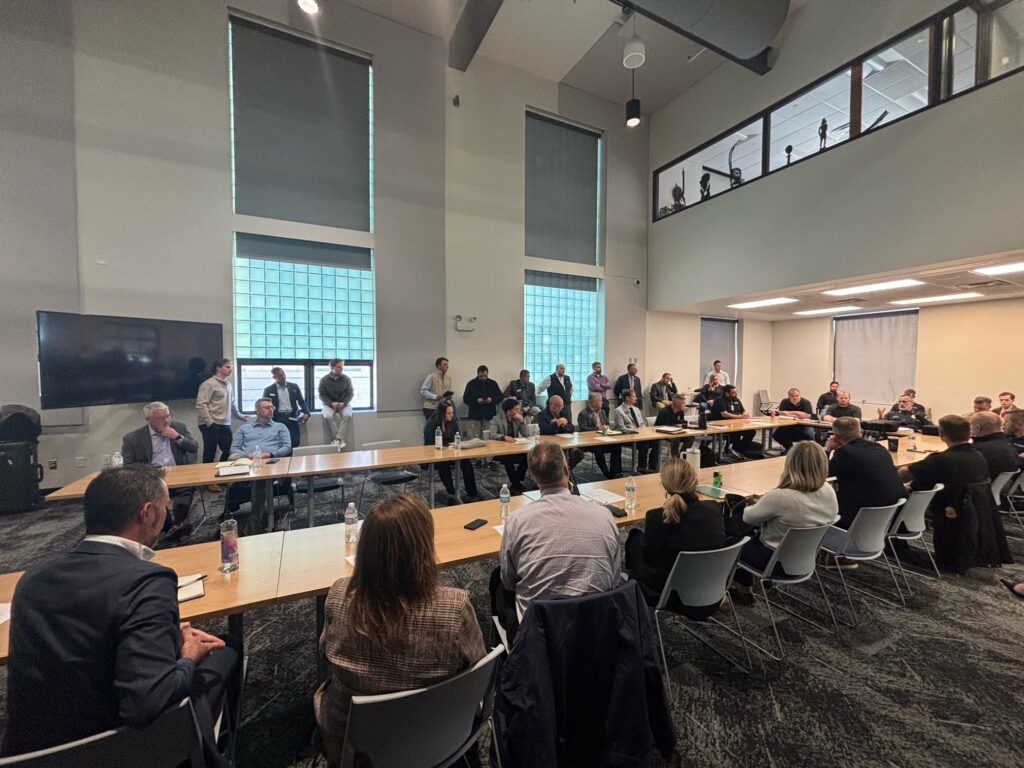By: Dawn Zoldi
When drone threats meet crisis planning, the result looks less like science fiction and more like tomorrow’s headlines. That reality came into focus during a recent counter-uncrewed aircraft systems (C-UAS) tabletop (TTX) exercise co-hosted by GrandSKY and the Venable Law Firm. This immersive homeland security simulation explored how quickly chaos can unfold when drones disrupt a quiet American city…and more importantly, what we all need to do to stay one step ahead of this threat.
A Simulated Crisis with Real Stakes
The TTX took place at The HIVE, a Grand Forks technology accelerator dedicated to bolstering the region’s uncrewed aircraft systems industry. Set in a fictional North Dakota city, the exercise unfolded around a fast-moving scenario. A coordinated drone attack targeted the airbase, a public campus, and nearby infrastructure. Within minutes, communications faltered, misinformation spread and local responders were forced to confront layered crises, ranging from power disruption to airborne threats, all under the glare of social media scrutiny.
What separated this event from a typical TTX was how the Venable team grounded the scenario in both geography and capability. The region, home to the Grand Forks Air Force Base, GrandSKY’s unique uncrewed aircraft system (UAS) test facility and North Dakota’s VANTIS beyond visual line of sight (BVLOS) network, is already central to the nation’s UAS ecosystem. That backdrop brought a true sense of realism and urgency to the simulated event. Participants, mostly from the local area, weren’t just theorizing. They were testing the seams between technology, law and real-world authorities in their own backyard.
Policy Meets Practice
Venable’s participation in the TTX added an essential policy-legal dimension to the collaboration by bridging the operational realities of homeland responders with the intricacies of federal law and liability. It also elevated the discussion beyond compliance into strategy: how to align public safety laws, federal authorities and private innovation to protect shared airspace from evolving threats. Throughout the exercise, participants from government, academia, industry and defense confronted hard policy questions, such as:
- Who has the legal authority to act in response to a a drone attack?
- Which agencies can engage in mitigation measures such as jamming or interdiction?

As the real-world framework currently stands, very few. Only select federal agencies, the DoD, Department of Justice (DoJ), Homeland Security (DHS) and Energy (DoE), possess active C-UAS legal authority–meaning the authority to engage in active detection and mitigation. (*Note-The recent government shut down has resulted in a lapse of key authorities for DoJ and DHS). That leaves state and local responders largely powerless, arguably unable to even detect, let alone neutralize, rogue drones that evade passive detection measures, despite being on the front lines. This “authority gap” dominated much of the discussion and underscored the urgent need for reauthorization of the federal C-UAS statute and expanded state-level capability development. (See prior AG coverage about the authority gap). Future frameworks, such as the FAA’s expected Part 2209 rule, will likely make it simpler to obtain temporary flight restrictions and localized drone management zones around critical events, which will close some of the regulatory gaps highlighted during the exercise.
The Human Factor in Homeland Resilience

Amid the discussion of radar ranges, RF signatures and data networks, the exercise also highlighted that technology alone cannot compensate for unclear policy. Without streamlined communication pathways, threat intelligence sharing and coordinated decision-making, even the most advanced detection networks will fail to protect the communities beneath them.
First responders, campus security coordinators and public information officers must make real-time choices under great uncertainty. The exercise revealed that in any drone-related crisis, the challenge isn’t just identifying an aircraft; it’s managing fear, misinformation and resource shortfalls while keeping people safe.
The scenario’s academic setting brought that reality home. Universities, often open and densely populated, lack specialized security infrastructure, yet play a vital role in community preparedness. For universities, readiness means forging partnerships with local responders, developing clear crisis communication plans and integrating simple airspace awareness tools. Education, in this sense, becomes prevention and empowerment for communities to treat drone security as both a technical and social challenge.
GrandSKY’s Leadership Role in Counter-UAS Progress

Beyond the simulated chaos, the exercise showcased the promise of building a nationwide network of connected defense nodes, something GrandSKY is actively realizing. For GrandSKY, co-hosting the exercise reinforced its position as the nation’s epicenter of UAS innovation and defense collaboration. The organization’s presence on Grand Forks Air Force Base anchors one of the country’s most advanced commercial UAS flight centers firmly on a military flight line. This type of integration of public and private resources is critical to build real defenses against small aircraft threats.
During the same day as the TTX, GrandSKY announced its deployment of a foundational C-UAS architecture at Grand Forks Air Force Base. The system incorporates AeroVironment’s AV_Halo COMMAND Mission software and Titan-SV radio frequency (RF) C-UAS technologies to deliver critical detection, identification and tracking (DIT) capabilities across a layered defense architecture designed to protect high-value sites. As GrandSKY President Thomas Swoyer Jr. explained to UAS Magazine, the initiative “establishes the foundational sensor network necessary to understand and counter evolving drone threats.” It also positions Grand Forks as a proving ground for the nation’s C-UAS future.
That effort ties into Project ULTRA, a $100 million public-private partnership between GrandSKY and the Department of Defense (DoD), launched earlier this year, to focus on flying UAS logistics missions in the national airspace system (NAS), between military installations. Part of the ULTRA mission includes proving various UAS traffic management (UTM) and C-UAS capabilities.
Adding to this momentum, GrandSKY’s affiliate, GFHive Management LLC, recently won a five-year contract to operate The HIVE. The HIVE will continue to serve as both a startup incubator and collaborative workspace to connect innovators working across security, data analytics and UAS integration.
By combining C-UAS infrastructure at Grand Forks Air Force Base with The HIVE’s innovation ecosystem downtown, GrandSKY has stitched together the physical and economic layers of the region’s drone industry. Together, these developments made GrandSKY not just a natural partner to host a TTX exercise, but reinforce its position as both a living testbed for how homeland defense can evolve amid emerging threats and the cornerstone of a layered sensor network that could eventually span North Dakota and link into national defense infrastructure. That vision aligns well with growing congressional focus on drone defense consistency.
Real Lessons for a Real Threat
One takeaway emerged from the TTX: time is the rarest asset in a drone crisis. When small aircraft can reach their targets in under five minutes, every delay, from identifying the threat to deciding who’s in charge, magnifies risk. The event laid bare both the potential and the peril of America’s rapidly evolving UAS environment.
The conversations were candid, the observations sobering. The outcome? A collective call for interagency coordination, enhanced public-private partnerships, realistic training and policy agility to keep pace with technology. It’s clear that no single organization, military, private, or municipal, can defend the skies alone. The answer will come from collaboration, readiness and shared trust, grounded in realism rather than rhetoric.
The sky over North Dakota has long symbolized openness and innovation. Today, it’s also a proving ground for national defense, civic resilience and economic opportunity. As GrandSKY and Venable’s initiative demonstrated, the question isn’t whether drone threats will materialize, but how ready the nation will be when they do.

